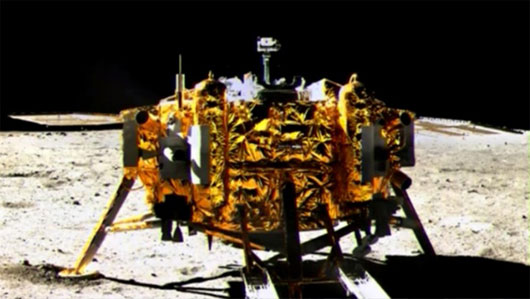China launched ships collecting specimens from the moon in 2017
China is implementing a plan to launch the Russian moon lunar exploration ship 5 in 2017, Xinhua cited China 's Science, Technology and Defense Industry Committee.
"The development of the Hang Nga 5 vessel is proceeding smoothly , " said a committee spokesman, Wu Zhijian, at a press conference today.
After the success of the Hang Nga 3 ship, she landed on the lunar surface and released the self-propelled Rabbit ship to explore "sister Hang", China's ambitious moon program (consisting of three phases, orbit, landing, taking off) completed the second stage.
At the third stage, China will launch two Hang Nga 5 ships and Hang Nga 6 flying to land on the lunar surface, collecting specimens of soil, stone . and taking them to take them back to Earth.

Hang Nga 3 probe is on the moon - (Photo: AFP)
The third phase of the program will be more difficult because of many technological challenges that must be overcome such as the probe taking off from the lunar surface, capturing and packing specimens, assembling on the moon's orbit, returning to the Left. land with high speed."It's all new to China," said Wu Zhijian , a spokesman.
Also according to Wu Zhijian, Hang Nga 3's reserve probe, Hang Nga 4, will be adjusted to test the technology of Hang Nga 5.
Reportedly, before the mission of Hang Nga 3, the most populous country on the planet has twice sent exploration ships to orbit Earth's natural satellite Hang Nga 1 and Hang Nga 2.
In October 2007, the Hang Nga 1 ship flew into space with the Truong Chinh 3A rocket. This first Chinese moon probe sent some pictures of the surface of "Ms. Hang" to Earth before ending her mission by stabbing the moon after 16 months of traveling in space.
Then, in October 2010, Hang Nga 2 left the launch pad at the Xichang Satellite Launch Center, southwestern Sichuan Province to fly to the moon's orbit and the mission to draw a detailed map of the satellite.
In its space ambition, China plans to send people to the moon by 2020.
- The world's first electric-powered vessel was launched in China
- China experimented with technology to collect soil samples from the Moon
- China launched ships to the moon at the end of the year
- China launches spacecraft to explore the dark areas of the Moon
- China farewell the Moon exploration robot
- China responded to the ship Hang Nga to the Dark Moon in 2018
- Specimen worth 800 million USD
- The US sold the wrong sample bag from the Moon
- Russia will launch ships to collect specimens from the moon Mars
- China has started producing Hang Nga 3 ships
- Hang Nga ships set a record high in space
- China launched the moon probe satellite
 Van Allen's belt and evidence that the Apollo 11 mission to the Moon was myth
Van Allen's belt and evidence that the Apollo 11 mission to the Moon was myth The levels of civilization in the universe (Kardashev scale)
The levels of civilization in the universe (Kardashev scale) Today Mars, the sun and the Earth are aligned
Today Mars, the sun and the Earth are aligned The Amazon owner announced a secret plan to build a space base for thousands of people
The Amazon owner announced a secret plan to build a space base for thousands of people